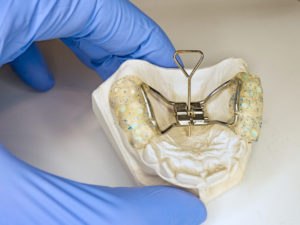
Braces and Invisalign® Teen are both really effective orthodontic treatments. But they can’t always do the job on their own. When a patient has a small or narrow upper jaw, sometimes, an appliance called a rapid palatal expander is needed for skeletal correction, either before or during comprehensive treatment.
While there are ways to expand an adult’s upper jaw, a rapid palate expander is generally used for kids and teens who are still growing. Since their skeleton is developing and flexible, guiding jaw growth is much easier.
In this post, the experts at Richard Chan Orthodontics will be sharing everything parents need to know about treatment with an orthodontic expander.
 What is a Rapid Palatal Expander?
What is a Rapid Palatal Expander?
A rapid palatal expander (RPE) is a common orthodontic appliance used in phase 1 orthodontic treatment or comprehensive treatment with expansion. Though there are removable palatal expanders, fixed expanders, meaning the appliance stays in place until expansion is complete, are often preferable for younger patients.
The maxilla (the bone of the upper jaw) is made up of two pieces that don’t fuse together until the mid-teenage years. A palatal expander uses gentle pressure to separate the pieces and widen the palate.
This can help make room for all of the permanent teeth to fit properly and fixes discrepancies between the upper and lower jaw to create an ideal bite (the way the top and bottom teeth come together).
How Does an Orthodontic Expander Work?
The device is secured around the back teeth and has two halves that fit against the roof of the mouth. The halves are joined together with a screw at the center.
You or your child will activate the expander by placing a key in the screw and turning it. Each turn creates tension that exerts gentle pressure on the midline suture, the point where the two maxillary bones meet, and the molars. This pressure pushes the maxillary bones apart and widens the jaw.
Once your child reaches the prescribed amount of expansion, the appliance will stay in place for several months so new bone can form between the halves of the maxilla, making the expansion permanent.
As we said above, an expander might be used during early orthodontic treatment before a child has all of their permanent teeth. Normally, however, the expander is used during a comprehensive treatment plan, where the child wears an expander for about six months before we remove it. Immediately after the expansion is completed, orthodontic treatment with braces or Invisalign Teen is used to fine tune the bite and straighten the teeth.
At Richard Chan Orthodontics, we always treat kids conservatively. And, while there are cases where two phases of treatment are needed, more often than not, we can achieve the same results with a single phase of treatment. Therefore, Dr. Chan may recommend combining an expander with braces. When the goals for expansion are achieved, he’ll take the expander out and your child will continue with braces.
When is a Rapid Palate Expander Needed?
There are other instances where an expander could be needed, such as certain cases of an underbite, but these are the most common reasons kids and teens require maxillary expansion:
A Crossbite
A crossbite is when some of the bottom teeth sit outside of the top teeth. A crossbite can be anterior (involving front teeth) or posterior (involving teeth in the back). Often, a posterior crossbite that’s skeletal in nature is due to the upper jaw being too narrow in relation to the lower jaw.
When that’s the case, expansion could be the best course of action. If not treated, patients with a posterior crossbite can compensate by shifting their jaw to the side, causing permanent changes in their facial structure. Crossbites can also result in jaw and TMJ pain and worn teeth.
Airway Issues
Breathing through the nose helps the lungs absorb oxygen, filters out impurities, adds moisture to the air, and even plays an essential role in kids’ growth. When nasal breathing isn’t possible and kids resort to mouth breathing, it has a negative impact on the development of their jaw and facial structures and can lead to sleep-disordered breathing, which includes obstructive sleep apnea.
Upper expansion widens the nasal floor (the palate is the floor of the nose), makes more room for the tongue and permanent teeth, and helps open the airway. This can enable kids to breathe easier, prevent or reduce sleep-disordered breathing and the associated side effects, and stop mouth breathing from impacting their appearance and health as an adult.
Severe Crowding
Crowding occurs when the jaw is too small to fit all of the permanent teeth. Teeth might twist, overlap, or even become impacted (stuck beneath the bone). Crowded, crooked teeth are harder to clean, which increases the risk of tooth decay and gum disease. Crowding can also cause uneven wear and interfere with function.
By widening the upper jaw with an expander, the teeth will have enough space and extractions can be avoided. Expansion may also create room for impacted teeth (commonly the canine teeth) to erupt without needing oral surgical procedures or extractions.
How Long Does Expansion Take?
The actual expansion only takes a few weeks. But the expander needs to stay in place for a while longer to give new bone time to form in the space between the maxillary bones. This is what stabilizes the expansion. On average, patients wear an expander for about six months.
Does a Rapid Palatal Expander Hurt?
We know, the idea of palate expansion does seem a little intense. But, because the maxillary bones in kids and teens aren’t fused together, manipulating them isn’t painful and only a small amount of tension is needed to shift them apart.
That said, while your child won’t feel severe pain from a rapid palatal expander, they may have mild soreness and pressure after turning the key, particularly during the first several days.
To keep them comfortable, have them stick with a liquid diet (soup, smoothies, etc.) for the first day and then soft foods for a couple of days to a week. It’s also a good idea to activate the expander at night, so by the time your child wakes up, most of the pressure is gone.
Are There Other Side Effects From an Expander?
Chewing and speaking can feel weird at first. Within a few days, your child or teen will get used to having the expander in their mouth and their ability to chew and speak will return to normal.
If you notice a space forming between your child’s front teeth, have no fear! This is completely normal and a sign that the expander is working and their jaw is widening. We’ll close the gap with braces or Invisalign.
How to Adjust an Expander
Dr. Chan will show you and your child how to adjust an expander. Sometimes it can take doing it yourself a few times to feel confident, but, we promise, it’s simple. Here’s how to activate the expander:
- Tip the head back.
- Have someone help shine a light into the mouth so you can see better.
- Put the key Dr. Chan gave you into the hole at the front center of the appliance.
- Push the key toward the back of the mouth until it stops and you can see the next hole.
- Carefully remove the key from the mouth. You should be able to clearly see the new hole for the next turn.
Depending on your child’s age, Dr. Chan may recommend either two turns per day (usually for older children/teenagers), or one turn every other day (usually for younger children). He will inform you how often and how many turns total.
What Happens if You Turn an Expander Too Much?
Patients are sometimes curious about what happens if you turn your expander too much. Turning the expander more than prescribed will compromise the results and cause more discomfort. It will not speed up treatment.
What if My Child Forgets to Activate Their Expander?
If your child forgets to activate their expander, do not do two turns the next time. Keep going with one turn per time, and add the missed turn to the end. While missing one turn isn’t a huge deal, be sure to keep in mind that adjusting the expander according to Dr. Chan’s directions will keep your child’s treatment plan on schedule.
How to Take Care of an Expander
Orthodontic appliances give food debris and plaque more places to hide. So, when wearing an expander, have your child or teen brush their teeth in the morning, after meals and snacks, and before bed. They should continue flossing once daily too.
Kids will want to gently brush their expander, including the screw and bars, when they brush their teeth. If they’re at school or out somewhere and forget their toothbrush, they can swish with water to keep the appliance clean until they can brush again.
As for eating with an expander, the food restrictions are similar to those kids have with braces. Avoid anything really hard, chewy, or sticky like whole, raw apples, caramels, hard pizza crust, gum, and licorice.
What are the Benefits of Expansion?
When a rapid palatal expander is necessary, the benefits are significant. Expansion can:
- Help kids and teens avoid the need for corrective jaw surgery
- Prevent the need for tooth extractions
- Open the airway and encourage nasal breathing
- Guide growth to correct a crossbite, crowding, and other skeletal concerns
- Create a wider, more aesthetically pleasing smile
- Make room for impacted teeth to erupt on their own
Schedule a complimentary consultation at Richard Chan Orthodontics in Bothell, Monroe, and Mill Creek, WA or Juneau, AK to get personalized treatment recommendations for your child or teenager. If a rapid palate expander is needed, Dr. Chan will walk you through his diagnosis, the process, and what to expect, so you feel fully informed about your child’s smile journey.

